We find out about the best job in the world on Naked Oceans this month as we take a look at what its like to work in the ocean realm. Sarah chats with a host of marine scientists who work in one of the top spots in the world for ocean research. We hear from someone who as well as doing his own science is using cutting edge communication tools to inspire the next generation of marine scientists and conservationists in two very different parts of the planet. And in Critter of the Month we meet a playful denizen of British waters that like nothing more than messing about with human scuba divers.
In this episode
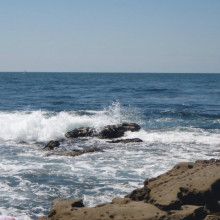
01:30 - Why marine science is the best job in the world
Why marine science is the best job in the world
with Paul Jensen, Miriam Goldstein, Michael Latz, Scripps Institution of Oceanography
 Three marine scientists from Scripps Institution of Oceanography, working in different fields, all explain how they ended up working in marine science, what the best part of the job is (clue: they have a great view of the beach), and give some words of wisdom for anyone thinking of following in their footsteps...
Three marine scientists from Scripps Institution of Oceanography, working in different fields, all explain how they ended up working in marine science, what the best part of the job is (clue: they have a great view of the beach), and give some words of wisdom for anyone thinking of following in their footsteps...
Sarah - I took a trip to Scripps Institution of Oceanography in San Diego California and chatted to a few of the scientists there about how they ended up doing what they do, and what they love about being marine scientists.
To start off with, I asked Paul Jensen, who works on marine microbes, and Miriam Goldstein who works on zooplankton how they ended up working in marine science...
Paul - I grew up in New York City and so I wasn't really exposed to much of the marine environment. But I was always interested in marine science as I think many people are as they're growing up, watching Jacques Cousteau on TV and all those sorts of things.
So when I went to college I found a program where I could major in marine biology and that got ms started. But there are a lot of different paths to a career in this field, and I took a slightly different one, in that my graduate degrees were spread out over time, because I would work for a while, then I would go back to school and get another degree, and so it wasn't necessarily a traditional path.
Miriam - I'm a bit slow perhaps so it was most of the way through college. I started out as an English major and then I needed a job. So, a friend of mine from theatre got me this job in a lab. He said 'Oh you know, you'll like it. You're scanning all these slides", because this was before digital cameras, which makes me sad to say.
So this lab was taking pictures of some of the most biodiverse marine environments in the work, like in the Seychelles. So I scanned all those slides and I started to become really interested and what were these things? And what were the questions that we were asking? So then I got sucked into marine ecology and ended up doing independent research in this lab, and suddenly I was on the path to become a marine biologist.
Sarah - So not everyone takes an obvious route into the job, and you don't have to live by the sea to be inspired by it.
All of the scientists I spoke to agreed that they love what they do. So, I had to ask, what's the best thing about their job and the best part of coming to work each day. First we'll hear from Michael Latz, who showed me some of the beautiful bioluminescent dinoflagellates that he works on in his lab, then Paul and Miriam again...
Michael - Unfortunately, you can't see where we're sitting, but we're in an office overlooking the ocean, the Pacific Ocean, with the waves and there's some dolphins offshore, it's incredibly beautiful.
So, if you want to be a marine biologist it's really nice if you can work along the seashore. And I've been lucky to be able to do that.
So the location is beautiful. Coming in to work, you come to the beach. So, I work at the beach every day.
Paul - The best part of the job is when I'm not coming here to work in my office, but when I'm out in the field, for sure. And that's really the best part of a career in marine science is that you can choose what you're interested in studying and you can choose where you want to study your interests and go there and do field work and be in the water and see some really interesting habitats.
Miriam - There's two best bits. One is that going to sea is fantastic. It's wonderful. I love going to sea and I love seeing my plankton net come up and never know really what's going to be in it, it's different every time.
And then the other fantastic thing is being able to answer the questions that you're asking. Because you're asking these questions of the world and then doing all this work to try to make sense of them, and when something actually does make sense after all the going to sea and in my case, the getting sea sick, and coming back, and all these things, and you're actually able to find out something that no-one else has ever found at. That's an amazing feeling.
Sarah - And Michael agreed with Miriam about the excitement of finding out new things being a major draw of the job...
Michael - The part I like best about the job is the scientific discovery. I love doing experiments. I love figuring out how to develop a protocol of how to do an experiment. I like working in the laboratory, I like working with equipment and computers and putting together essentially and engineering solution for how to do something.
 Sarah - I have to agree that the combination of scientific discovery and those amazing views from the offices at Scripps must be a pretty good incentive to go to work!
Sarah - I have to agree that the combination of scientific discovery and those amazing views from the offices at Scripps must be a pretty good incentive to go to work!
But of course, it's not all 'plain sailing', and not all about going out on research vessels all the time. I asked Miriam what the reality of her life as a marine researcher really is...
The reality is you do get to do expeditions but a month at sea can lead to three years of lab work, and writing. It very much depends on specifically what you're doing. If you are observing marine mammal you're going to do that a lot at sea. But if you're doing something like me with zooplankton you can't really process them on a microscope at sea, so you take a lot of samples, preserve them all as fast as you can, put them in jars, and then you deal with them back at the lab when the ground isn't moving anymore.
I always get sea sick. You can be a marine biologist and get sea sick, there are many excellent marine biologist who spend a significant time shall we see closely observing over the side of the ship.
So I go to sea about once a year for a month and then spend the rest of the year working out those samples and writing work at my computer.
Sarah - I think the seasickness would put me off a little bit, though Miriam did say that her sickness only lasts a couple of days, and that once she's found her sea-legs, she's fine.
So, to succeed as a marine scientist, what kind of person do you need to be? Michael lays out what he feels are the necessary attributes and Paul explains what he's learned from his career so far...
Michael - I think you need to be very curious about the world around you. Very interested in how it works and have a desire to learn. As any kind of scientist you're learning and so that process for me is very inspiring. The goal of gaining knowledge and that knowledge helps us to better understand how the works around us.
Paul - What I've learned from the process is that its probably one third being good at what you do, it's one third luck - being in the right place at the right time - and it's one third persistence. And if you stick with something for a while and you believe in it and you work hard at it then you can end up making a career in doing what you really want to do.
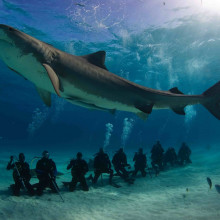
10:07 - Free-food doesn't change sharks
Free-food doesn't change sharks
 A new satellite tracking study suggests that when scuba diving companies in the Caribbean feed tiger sharks to attract them to dive sites it does not radically alter their behaviour.
A new satellite tracking study suggests that when scuba diving companies in the Caribbean feed tiger sharks to attract them to dive sites it does not radically alter their behaviour.
The spectacle of seeing sharks underwater is becoming a major draw for scuba divers - studies have shown the huge revenues possible from shark ecotourism compared to killing sharks for their fins. But a major criticism of the booming shark dive industry is the many outfits that feed sharks to attract them predictably to dive sites. But what impact does this actually have on their behaviour and ecology?
For the first time, satellite tags have been used help answer that question. Neil Hammerschlag from the University of Miami, led a team of shark taggers in Florida - where shark feeding is illegal - and in the Bahamas, where tiger sharks are regularly fed.
11 tiger sharks were tagged in Florida and 14 in the Bahamas, and they were tracked for between 26 and 297 days.
The team expected that compared to Florida, the sharks in the Bahamas would swim around a smaller area, concentrated at the feeding sites. But as the satellite tracking data came in, they got a big surprise.
Not only did they find no evidence that the sharks getting a free-feed were swimming over a smaller area - the Bahamas sharks had huge home ranges almost five times larger than the Florida sharks - but the team also uncovered their previously unknown long-distance migrations of up to 3500 km into the open Atlantic. The tiger sharks seem to be following the Gulf Stream into food-rich areas that concentrate their prey.
Based on their findings, Hammerschlag and his team recommend that shark diving should not be dismissed out of hand, given the potential benefits that come from an increased awareness of sharks.
Find out more:
Watch
Neil Hammerschlag talking about this new studies.
R.J. Dunlap Marine Conservation Program
Hammerschlag et al (2012). Don't bite the hand that feeds: assessing ecological impacts of provisioning ecotourism on an apex marine predator. Functional Ecology.
Open Access paper
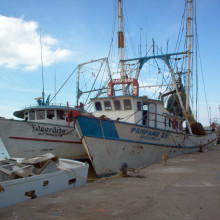
12:43 - Excluding fishermen can harm fisheries
Excluding fishermen can harm fisheries
The problem with fisheries management is that what a government decides will be best for conservation may not be best for the local people that rely on a fishery, and may in fact end up harming the fish stocks in the end. A study published in the February edition of Scientific Reports has shown just this in a Gulf corvina fishery off the coast of Mexico.
Brad Erisman, from Scripps Institution of Oceanography, and his colleagues used tracking systems to figure out the exact movements of the spawning fish, and of the fishing vessels, over time. They found that the peak in fish catch coincided with the peak in spawning activity.
 The research suggests that this fishery is a difficult case, where a no-take zone is being ignored by local fishermen because they have no choice economically but to fish there. Brad pointed out that one thing we could take away from the study is that these fishermen are doing something illegal that is harming wildlife, but he wanted to bring out the issue that clearly the locals want to be involved in decisions on helping to preserve the fishery, and now that we have more information on exactly where and when these Gulf corvina spawn, hopefully this will help fisheries scientists, fishermen and local government come to a decision that they all agree on.
The research suggests that this fishery is a difficult case, where a no-take zone is being ignored by local fishermen because they have no choice economically but to fish there. Brad pointed out that one thing we could take away from the study is that these fishermen are doing something illegal that is harming wildlife, but he wanted to bring out the issue that clearly the locals want to be involved in decisions on helping to preserve the fishery, and now that we have more information on exactly where and when these Gulf corvina spawn, hopefully this will help fisheries scientists, fishermen and local government come to a decision that they all agree on.
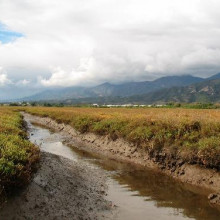
18:39 - Wetland critters survive Deepwater Horizon oil spill
Wetland critters survive Deepwater Horizon oil spill
It will soon be two years since the Deepwater Horizon oil spill in the Gulf of Mexico, and there is still a lot of concern over the impact it's had on marine and coastal ecosystems in the region.

A new study just out suggests that communities of small critters living in coastal salt marshes are vulnerable to oil exposure but at the same time quite resilient; and, so long as the plants they live in remain healthy, they can recover within a year.
As the oil swept across the Gulf back in 2010, Brittany McCall and Steven Pennings from the University of Houston in the US, went out and studied populations of crabs, snails, insects and spiders inhabiting ten salt marshes in Louisiana and Mississippi in areas subject to relatively low levels of oil contamination.
Compared to oil-free control sites, the abundance of salt marsh invertebrates in the oiled sites was around 50% lower, with the exception of the marine snail, Littorina, which was unaffected by the oil.
But, the good news is that, after a year, populations of all of the animal species studied had recovered.
This suggests that, even at low-levels of oil contamination, salt march inhabitant are impacted in the short term by lower levels of pollutants. Longer term, however, they do appear to be able to bounce back...
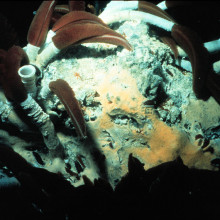
20:25 - Hybrid 'hydrothermal seep' ecosystem found
Hybrid 'hydrothermal seep' ecosystem found
Here on Naked Oceans, we've covered stories before on deep sea hydrothermal vents. But these aren't the only type of vent spewing mineral rich water into the deep sea.
Cold seeps, as the name suggests, don't belch out plumes of hot water, but instead cooler water, that's often rich in methane. Over the last three decades of research into deep sea vents, it was thought that cold seeps and hydrothermal vents were only found in separate, geologically distinct, areas of the ocean, and supported very different communities of life. 
But in recent years, they had been found in pretty close proximity, and now, a team led by Lisa Levin from Scripps Institution of Oceanography, has found a 'hybrid' ecosystem in an area off Costa Rica, that suggests the presence of what they term a 'hydrothermal seep' system.
The team used the Alvin research submersible to take sediment samples, water temperature and composition measurements, and pictures to observe the fauna living at the base of Jaco Scar, a seamount on a tectonic plate that is moving underneath the adjacent one. Their results suggested a hybrid system, with species that were usually found at either vents or seeps coexisting perfectly happily.
They suggest that we may need to think of vent and seep ecosystems as being on a continuum and not just confined to one group or the other, and some other areas where these new hybrid hydrothermal seeps might be found... That's all published in the Proceedings of the Royal Society B.
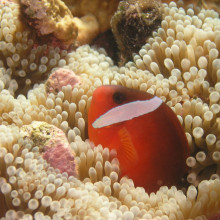
22:16 - Using cutting edge technology to inspire the next generation of marine scientists
Using cutting edge technology to inspire the next generation of marine scientists
with Joshua Drew, Field Museum of Natural History Chicago
 Joshua - So I was working in Fiji where we were describing new species and recognising the high levels of endemism in Fiji. And whenever we told people in the villages about that they became really excited about it, and I though it would be great if we could work more systematically and not just do it piecemeal from village to village, but rather get it engrained into the education system.
Joshua - So I was working in Fiji where we were describing new species and recognising the high levels of endemism in Fiji. And whenever we told people in the villages about that they became really excited about it, and I though it would be great if we could work more systematically and not just do it piecemeal from village to village, but rather get it engrained into the education system.
And so, I wanted to work with high schoolers in Fiji to teach them from the very beginning, you know 14-15 years old, about how special their marine resources are and how they're the stewards of those endemic species, that they're the people who are responsible for the health of the entire world's population of these species.
And that's a pretty big responsibility but it's also a big source of pride. We have the phrase Na ika kai viti, the 'Fijian Fish'.
Helen - As well as working with students in Fiji, Dr Drew also wanted to connect with people closer to home.
Joshua - It was distressing to me that the teens in Chicago aren't often exposed to wild and natural places and that they didn't have necessarily a sense of how beautiful and vibrant the marine world is, and that got me thinking about how do we best link up kids in Chicago with kids in Fiji, and it kind of hit me that they aren't different, that really I was trying to do the same thing just in two unique environments. But the methods I would use to get the youths engaged are pretty much the same and there's no reason why we couldn't do it as a unified program.
And I thought wouldn't it be cool if we could come up with this virtual classroom where we do away with the geographic distances between the students and we just let them communicate, and we let them talk about what matters to them simultaneously from opposite ends of the earth.
Helen - So, that's what Dr Drew did. Working with an NGO in Fiji and education specialists at the Field museum, he connected kids in Fiji and Chicago.
 Joshua - The real hallmark was getting the students learning from each other. So for instance we had a project where each student group would study one individual. We had one group in Chicago and one group in Fiji both work on white tipped reef sharks. And they researched it and we have them do a little bit of a documentary or a play about white tipped reef sharks, and they would video them and would post them to this custom social network site that we made.
Joshua - The real hallmark was getting the students learning from each other. So for instance we had a project where each student group would study one individual. We had one group in Chicago and one group in Fiji both work on white tipped reef sharks. And they researched it and we have them do a little bit of a documentary or a play about white tipped reef sharks, and they would video them and would post them to this custom social network site that we made.
And then both groups would review each other and say "oh that was great, you learned how these are benthic sharks so they live on the bottom and use their heads to wiggle into crevice and get parrotfish, but maybe you didn't talk about how they hunt in packs."
It was peer to peer learning and the students were critiquing and coming up with a stronger project. And that peer to peer is a much more effective way for students to get the information reinforced that just me standing up on high on a podium lecturing at them.
Helen - And at the end of the Semester, Dr Drew got the students in Fiji and Chicago to work on a project that ended up having some real-world conservation outputs.
Joshua - The final project was really awesome I love it. What we did was, I flew out to Fiji and we worked with the students there for a couple of weeks, and we worked with a village called Navakavu which is 10km outside the capital city of Fiji, Suva.
out to Fiji and we worked with the students there for a couple of weeks, and we worked with a village called Navakavu which is 10km outside the capital city of Fiji, Suva.
And the villagers of Navakavu are mostly fishermen and they had done a really good job of keeping their reefs clean. They had fishery wardens, they had tambu areas, these no-take areas set up, but yet their fisheries were still declining. So we went there are we wanted to figure out why this was.
So the Fijian students and I went in and we did a sevu sevu, which is a traditional welcoming ceremony where we were invited into the village and we talked to the chief and the village elders and we talked a little about why we were there and what we wanted to do.
And then, the Fijian students interviewed the fishermen in Fijian about why they thought their resources were declining, what the threats to their reefs were. The students videotaped these too and were able to translate them so the Fijian students made these mini documentaries about the village of Navakavu.
Helen - The message that came through loud and clear from the villagers in Navakavu village was that saw their reefs getting impacted by garbage washing in from the capital of Fiji, Suva.
So the Fijian students shared these mini documentaries with their friends in Chicago and together they brainstormed ideas of what to do about this problem of plastic waste.
 Joshua - What we ended up doing was writing two letters to the editor for the Fijian newspapers, the Fiji Times. And also coming up with a PSA, a Public Service Announcement, so a short video letting people know that polluting in Suva impacts reefs outside Suva. And it was really great because the students in Chicago came up with these ideas, they wrote them and as a class in Chicago we went down to Lake Michigan and we acted out this video where she showed that when you throw a plastic bag into the water it can end up in your food supply. It's a really funny video.
Joshua - What we ended up doing was writing two letters to the editor for the Fijian newspapers, the Fiji Times. And also coming up with a PSA, a Public Service Announcement, so a short video letting people know that polluting in Suva impacts reefs outside Suva. And it was really great because the students in Chicago came up with these ideas, they wrote them and as a class in Chicago we went down to Lake Michigan and we acted out this video where she showed that when you throw a plastic bag into the water it can end up in your food supply. It's a really funny video.
The thing that I love best about that is that as educators we stepped back, and we let the students come up with the ideas, and we let the students create and edit and shoot and put together both the videos and the letters. We helped make sure that the factual content was there, but this was really the students in the drivers seat. This was the students taking tenure over their own conservation activities, and that as a conservation biologist was really heartening to see.
Helen - Bringing together students in Fiji and Chicago, Dr Drew has been helping to spread the word about marine biology and ocean conservation in two very different parts of the world.
Joshua - The school in Fiji is a private school, a prep school, and I was really glad to work with the next generation of Fijian leaders. These students from Fiji are very smart. They're going to be the people who in 10-15 years are running the fisheries management council, the people who are going to be running the no-take marine protected area council.
I wanted to make sure that these people who are going to be in positions to help control and improve Fiji's environment at least got some exposure to why it's important to do marine conservation. And I wanted to at least have them start thinking that Fiji has really beautiful reefs that are still in relatively good shape and they have the power in their hands to make sure in 10-15 years when they're running the country that they can keep Fiji being one of these beautiful places in the world.
And on the Chicago end I wanted to show the students that if you have an interest in science that there's a lot of really cool careers you can do with it. Obviously I think being a marine biologist is the best job in the world and I'm totally biased in that aspect, but one of the great spinoffs of that was that two of the students who participated in the project are no interning here at the Field Museum over the summer where we're working on marine biology and marine conservation issues, and that's a really fantastic opportunity for them & myself.
 Helen - Those two lucky students, Amber & Darcae spent their summer working with Dr Drew at the Field Museum, helping him to study fish.
Helen - Those two lucky students, Amber & Darcae spent their summer working with Dr Drew at the Field Museum, helping him to study fish.
Amber - We do so many different things and it's really exciting. We do DNA analysis, we do morphological processing. We measure the fish, we measure the different parts of the fish, the dorsal and pelvic spines. I learn and lot and I absorb a lot so I can teach people, like I reach people at home, what I learned, and they find it exciting.
Darcae - I'm enjoying everything. There's not one part of my day that I don't like and everyday I go home and tell everybody what I did today and annoy them at how excited I was at work and they were just sitting at home.
Joshua - One of the things that's been really great for me is that the students aren't just doing grunt labour. They're actually doing the calculations and the statistical analyses that we need to help write these papers so they're not just getting me coffee they're doing honest to good work.
I'm just really impressed to see how the students who started out not really  knowing a whole lot about different species or different marine interactions, how in a relatively short period of time, transitioned from being really marine novices to being experts about it.
knowing a whole lot about different species or different marine interactions, how in a relatively short period of time, transitioned from being really marine novices to being experts about it.
I'm also really proud that they didn't just sit there with that information but they not only did the conservation act but that they're really telling everybody in their community about it and really starting to raise the awareness of it.
That was far more than I could have ever hoped for.
Find out more:
Joshua Drew's website
Read Dr Drew, Amber & Darcae's paper:
Drew et al (2012) Biodiversity inventories and conservation of the marine fishes of Bootless Bay, Papua New. BMC Ecology.
Fiji reef pollution Public Service Announcement video
Field Museum of Natural History, Chicago
Voise Academy High School, Chicago
Wildlife Conservation Society, Fiji
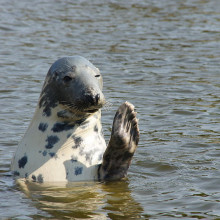
33:20 - Critter of the Month - Grey seal
Critter of the Month - Grey seal
with Jen Ashworth, Natural England
Hello I'm Jen Ashworth from Natural England, and if I was a marine creature I would like to be a grey seal, particularly a grey seal living on the Isle of Lundy, which is in the Bristol Channel. Grey seals seem to have a great life.
 They spend their time either swimming around in the sea, hiding in the kelp forest, and then when the tide is low go and sit on the rocks and watch people going by. You have quite a lot of divers at Lundy, and the grey seals seem to have a great time with the divers. They go in and get their whiskers tickled, dash up behind them and go pull the diver's fins. I think that would be really fun to do.
They spend their time either swimming around in the sea, hiding in the kelp forest, and then when the tide is low go and sit on the rocks and watch people going by. You have quite a lot of divers at Lundy, and the grey seals seem to have a great time with the divers. They go in and get their whiskers tickled, dash up behind them and go pull the diver's fins. I think that would be really fun to do.
Interesting fact about the grey seals is they were the first marine animals to be protected since 1914 and the population is doing really well. We have about 40% of the world's population in the UK and therefore I think life as a grey seal would be great.
Find out more:
Natural England
More on grey seals from the
BBC
- Previous The 5-a-Day Yellow Glow!
- Next Sensors and Sensibility










Comments
Add a comment